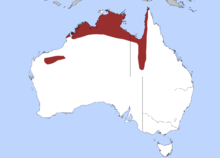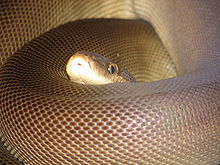Olive python
| Olive python | |
|---|---|

| |
| Scientific classification | |
| Domain: | Eukaryota |
| Kingdom: | Animalia |
| Phylum: | Chordata |
| Class: | Reptilia |
| Order: | Squamata |
| Suborder: | Serpentes |
| Family: | Pythonidae |
| Genus: | Liasis |
| Species: | L. olivaceus |
| Binomial name | |
| Liasis olivaceus Gray, 1842 | |

| |
| Distribution of the olive python | |
| Synonyms[1] | |
| |
The olive python (Liasis olivaceus)[2] is a species of snake in the family Pythonidae. The species is endemic to Australia. Two subspecies are recognized, including the nominate subspecies described here.[3]
Description
With adults reaching over 4 m (13 ft) in total length (including the tail), L. olivaceus is Australia's third-largest snake species (surpassed only by the amethystine python and Oenpelli python). Its high number of dorsal scale rows (61–72 at midbody), makes the skin look smoother than that of other pythons. The number of ventral scales is 355–377.[2] The colour pattern is a uniform chocolate brown to olive green, while the belly is usually cream-coloured.[4] The adult weight is typically 10–20 kilograms (22–44 lb), and a large female can exceed 20 kilograms (44 lb) in captivity.[5]
Unfortunately, this species is occasionally confused with the venomous king brown snake, Pseudechis australis, and may be mistakenly killed based on the misidentification.[2]
Distribution
L. olivaceus is found in Western Australia, the Northern Territory, and Queensland. The type locality given is "North Australia; Port Essington" (Northern Territory, Australia).[1]
Habitat
The olive python occurs in rocky areas, gorges, and especially rocky areas near sources of water. Typically, shelter is sought in caves and rock crevices, but individuals have also been found in hollow logs and burrows under rocks.[2]
Diet
The diet of L. olivaceus consists of birds (ducks and spinifex pigeons), mammals (including rock wallabies and fruit bats), and other reptiles.[2] It prefers to lie in wait next to an animal trail to ambush its prey. Alternatively, it is a strong swimmer and also hunts in waterholes, striking at prey from under the water.[4]
It is also known to prey on monitor lizards and juvenile crocodiles.[6]
Reproduction
Mating activity of olive pythons starts in May and continues until mid-July. When successful, this is followed by a gestation period of 81–85 days, after which the oviparous female lays 12–40 eggs in late spring.[4] The average clutch size is around 19 eggs.[2] The hatchlings emerge after an incubation period around 50 days, each measuring about 35 cm in length.[4]
Subspecies
| Subspecies[3] | Taxon author[3] | Common name[2] | Geographic range[5] |
|---|---|---|---|
| L. o. barroni | L.A. Smith, 1981 | Pilbara olive python | Australia in the Pilbara region of Western Australia |
| L. o. olivaceus | Gray, 1842 | common olive python | Australia from the Kimberley region in Western Australia to the area around Mount Isa in Queensland |
Captivity
The olive python is often kept as a pet and is bred in captivity. It is technically an advanced-level species due to its size, habitat requirements, and strong feeding response, requiring a terrarium of a minimum of 2.4 metres (8 ft) long, by 1 metre (3 ft) high and 1 metre (3 ft) wide. If raised properly, it is noted to be friendly, curious, and calm. In removing it from its enclosure, snake hooks be used so as to prevent the feeding response from being triggered, and once out, it can generally be freely handled calmly due to its placid nature.[7][better source needed]
Images

References
- ^ a b McDiarmid RW, Campbell JA, Touré T (1999). Snake Species of the World: A Taxonomic and Geographic Reference, Volume 1. Washington, District of Columbia: Herpetologists' League. 511 pp. ISBN 1-893777-00-6 (series). ISBN 1-893777-01-4 (volume).
- ^ a b c d e f g Olive python, Liasis olivaceus Archived 24 September 2015 at the Wayback Machine at Pilbara Pythons Archived 18 December 2014 at the Wayback Machine. Accessed 4 August 2008.
- ^ a b c "Liasis olivaceus". Integrated Taxonomic Information System. Retrieved 4 August 2008.
- ^ a b c d Olive Python Archived 24 October 2007 at the Wayback Machine at Currumbin Wildlife Sanctuary Archived 24 October 2007 at the Wayback Machine. Accessed 4 August 2008.
- ^ a b Captive maintenance and breeding of olive python Archived 4 March 2008 at the Wayback Machine at Victorian Herpetological Society Archived 18 July 2008 at the Wayback Machine. Accessed 4 August 2008.
- ^ "Snake vs crocodile: A dramatic showdown - ABC (none) - Australian Broadcasting Corporation". www.abc.net.au.
- ^ "Olive Python Fact Sheet". 28 October 2013.
Further reading
- Barker DG, Barker TM (1994). Pythons of the World. Volume I. Australia. Lakeside, California: Advanced Vivarium Systems. xviii + 171 pp.
- Boulenger GA (1893). Catalogue of the Snakes in the British Museum (Natural History). Volume I., Containing the Families ... Boidæ ... London: Trustees of the British Museum (Natural History). (Taylor and Francis, printers). xiii + 448 pp. + Plates I-XXVIII. (Liasis olivaceus, p. 79 + Plate IV, figure 2).
- Cogger HG (2014). Reptiles and Amphibians of Australia, Seventh Edition. Clayton, Victoria, Australia: CSIRO Publishing. xxx + 1,033 pp. ISBN 978-0643100350.
- Gray JE (1842). "Synopsis of the species of prehensile-tailed Snakes, or Family Boidæ". Zoological Miscellany 2: 41–46. (Liasis olivacea, new species, p. 45).
- Reynolds, R. Graham; Niemiller, Matthew L.; Revell, Liam J. (2014). "Toward a Tree-of-Life for the boas and pythons: Multilocus species-level phylogeny with unprecedented taxon sampling". Molecular Phylogenetics and Evolution 71: 201–213.
- Smith LA (1981). "A revision of the Liasis olivaceus species-group (Serpentes: Boidae) in Western Australia". Records of the Western Australian Museum 9 (2): 227–233. (Liasis olivaceus barroni, new subspecies, pp. 231–233, Figure 2).
- Wilson, Steve; Swan, Gerry (2013). A Complete Guide to Reptiles of Australia, Fourth Edition. Sydney: New Holland Publishers. 522 pp. ISBN 978-1921517280.

